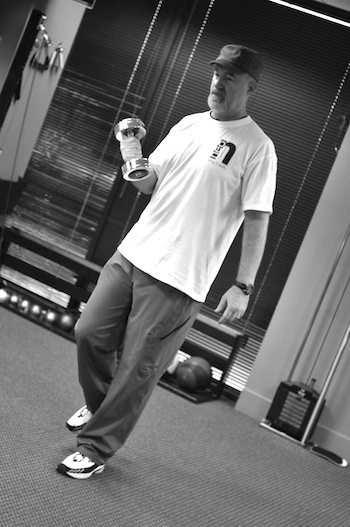- You are here:
- Home »
- Blog »
- Fitness After 40 »
- The Exercise Mistake That Nearly Everyone Makes
The Exercise Mistake That Nearly Everyone Makes
“Don’t let the perfect be the enemy of the good.” – Voltaire
When it comes to exercise, moving with proper form is important. Proper exercise form helps reduce the risk of injury and maximizes the benefit of the drill.
But, could perfect form be a mistake? And when is the form you use good enough? And how do you know?
In this post, I’ll share the answer to those questions and three ways to know if your form is correct and good enough.
An Easy Way To Know if Your Form is Good Enough
To get the most of your training, your form needs to be “good enough” and not perfect.
Let’s take an example – a Flamingo Gunner or a single leg stance, bicep curl. This drill requires you to stand on one leg while  holding a dumb bell in the opposite hand and perform a “bicep curl”.
holding a dumb bell in the opposite hand and perform a “bicep curl”.
Your intention is to keep the hips still and the body still other than the movement of the elbow. This challenges balance, core control, as well as strength of the arm.
If you start with just the weight of your arm as the load instead of a dumb bell, you’ll find this drill easy to do. As you increase the weight of the dumb bell, you’ll notice that holding your balance and keeping the hips level becomes increasingly difficult.
With no load in your hand, you can execute this drill with picture perfect form. But, it’s of little to no use to you at that intensity. You have to fatigue in order for your body to adapt and get stronger.
And even if you add weight, let’s say 5lbs, you can probably perform a lot of reps before you notice any fatigue or break in your form.
Some place between no weight and a ton of weight is the happy point.
So, how do you figure this out?
You want to achieve enough fatigue that you struggle with the drill but not struggle so much that you run the risk of injury or simply fail to get the benefits of the drill.
How to Train with Less Than Perfect Form
There are three parts to solving this.
Part 1. With each drill is a goal number of repetitions. And for most drills, you want to achieve a certain level of fatigue within the first round and a maximum level of fatigue by the final round of the Element.
On a scale of 1-10, where 1 is almost no fatigue and 10 is you’re completely trashed, the Flamingo Gunner fatigue goal ranges from a 5 to 7 on the fatigue scale.
Part 2. Some people have a hard time interpreting fatigue on a scale. I’ve had clients who just stare at me and shrug their shoulders when I ask them to rate their fatigue. Well, the good news is your body will do it for you and that’s Part 3.
 Part 3. When you hit about 70% of your maximum (so this would be a 7/10 on the scale), your face will make involuntary movements and your body will start showing signs of losing form. We call it a “pain face” because it looks like the facial grimacing a person makes in pain.
Part 3. When you hit about 70% of your maximum (so this would be a 7/10 on the scale), your face will make involuntary movements and your body will start showing signs of losing form. We call it a “pain face” because it looks like the facial grimacing a person makes in pain.
So, when you first notice the “pain face” and you’re struggling to keep your form, you’re right on the edge. That’s a good thing. But,when your “pain face” turns into more of a crazy face – your eyes are squeezed shut, your head tilts back like you’re going to morph into a werewolf- and your body starts lurching, swaying, becoming uncoordinated, unable to finish the motion, it’s time to stop.
The Bottom Line
To get the most out your exercise, you should wear a “pain face”, but not a “crazy face, and struggle with your form by the end of each round and certainly by the end of all rounds.
